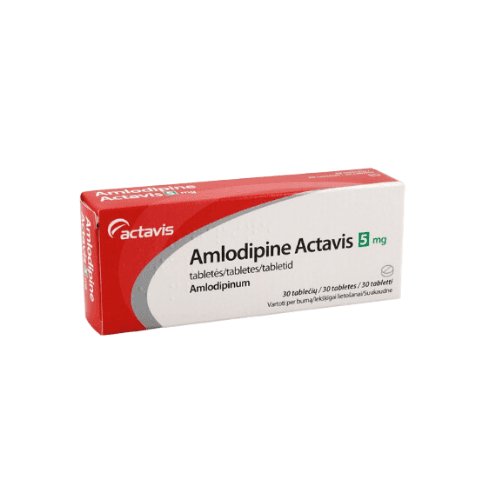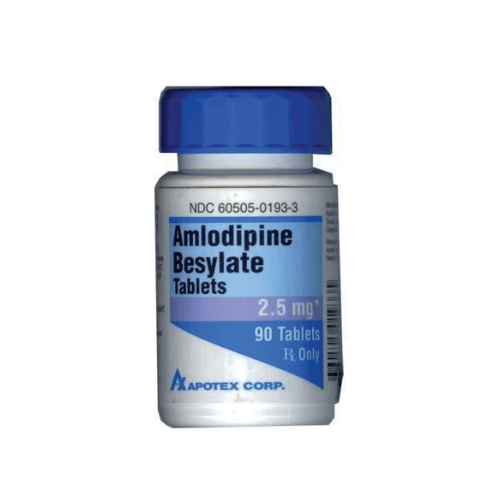Shipping with this method takes 3-5 days
Amlodipine Tablets for Hypertension
Price range: $28.99 through $38.99
Secure Encrypted Payments
Amlodipine is a calcium channel blocker used to lower blood pressure and help prevent chest pain. This page explains what it treats, how it works, and how to order with US delivery from Canada. It also outlines safety basics and ways to find savings with amlodipine without insurance.
What Amlodipine Is and How It Works
This medicine belongs to the dihydropyridine class of calcium channel blockers. It relaxes vascular smooth muscle, which reduces peripheral resistance. That action can lower blood pressure and improve oxygen supply to the heart. The treatment is widely used alone or with other antihypertensives for long-term management of hypertension and for chronic stable or vasospastic angina.
YouDrugstore is a licensed Canadian pharmacy in Manitoba. Pharmacists review prescriptions before dispensing.
It starts working gently and maintains steady control with regular daily dosing. Many patients take it with other agents such as ACE inhibitors, ARBs, or thiazide diuretics when combination therapy is appropriate. For condition background and lifestyle tips, see Hypertension and Angina.
Who It’s For
This therapy is indicated for adults with essential hypertension and for chronic stable or vasospastic angina. It may be used as monotherapy or added to existing regimens when additional control is needed. People with very low baseline blood pressure, severe aortic stenosis, or known hypersensitivity to components should avoid it. Those with significant liver impairment may require closer monitoring, as clearance can be reduced.
Discuss current conditions such as heart failure, recent myocardial infarction, or advanced liver disease with a prescriber. Patients who are pregnant, planning pregnancy, or breastfeeding should review risks and benefits with a healthcare professional.
Dosage and Usage
Follow the instructions on the prescription label. Take the tablet once daily, at the same time each day, with or without food. Swallow whole with water. Do not crush or split unless a clinician or pharmacist confirms it is appropriate for the specific product. If other blood pressure medicines are prescribed, take them exactly as directed. See the official product label or talk to a pharmacist if uncertain.
Consistency helps maintain steady effect. Consider a routine tied to a daily habit to support adherence. Keep a record of readings as advised by a clinician. It can be helpful to check blood pressure at home and bring logs to appointments.
Strengths and Forms
This treatment is available as oral tablets in multiple strengths. Availability can vary by manufacturer and market.
- Common form: film-coated tablets for once-daily use
- Typical strengths: 2.5 mg, 5 mg, and 10 mg
- Most packs include child-resistant containers
- Color and imprint can differ by manufacturer
- One exact strength listing: amlodipine 10 mg tablets
Check the package for the manufacturer name and any distinct imprint. If the product appearance differs, verify the DIN/NDC or consult a pharmacist.
Missed Dose and Timing
If a dose is missed, take it when remembered unless it is near the next scheduled dose. If it is close to the next dose, skip the missed tablet and resume the regular schedule. Do not double up. If frequent doses are missed, speak with a clinician about reminders or pill organizers.
Storage and Travel Basics
Store tablets at room temperature in a dry place, away from moisture and direct light. Keep the medication in the original container with the label intact and out of reach of children and pets. Avoid storing in bathrooms or cars where heat and humidity can fluctuate.
When traveling, carry the prescription-labeled container in a personal bag, not checked luggage. Bring a copy of the prescription and a medication list. Plan enough supply for the entire trip, plus a small buffer in case of delays. Security checkpoints may ask to see the original label.
Benefits
This calcium channel blocker offers once-daily dosing and generally steady blood pressure control. It can help reduce angina episodes when used as directed. The tablet form is convenient, and it can be used with many other blood pressure medicines. Many clinicians prefer it when a vasodilatory approach is desired.
Side Effects and Safety
- Common: ankle or foot swelling, flushing, dizziness, headache
- Other: fatigue, palpitations, nausea, abdominal discomfort
- Less common: drowsiness, muscle cramps, gingival changes
Serious reactions are uncommon but can include severe hypotension, worsening angina in rare cases when starting therapy or adjusting doses, or allergic reactions such as rash, itching, or swelling of the face or tongue. Seek urgent care for signs of severe reaction, chest pain that changes or intensifies, or fainting. Those using insulin or sulfonylureas are not typically at increased hypoglycemia risk from this class alone, but overall regimens should be monitored by a clinician.
Drug Interactions and Cautions
Strong CYP3A4 inhibitors, such as certain azole antifungals or macrolide antibiotics, may increase exposure. Potent inducers like rifampin or carbamazepine may reduce effect. Grapefruit products can interact with some calcium channel blockers; discuss dietary habits with a clinician. When combined with other antihypertensives, additive blood pressure lowering can occur.
Statin interactions are notable with some agents; clinicians often limit simvastatin doses when co-administered. If taking agents for heart rhythm, erectile dysfunction, or other cardiovascular conditions, review all medicines with a pharmacist. For a related therapy profile, see Diltiazem, and for broader condition care see Treat Hypertension.
What to Expect Over Time
Blood pressure reduction is typically gradual. The effect is maintained with consistent daily use. Some patients notice ankle swelling or flushing early on; these effects may stabilize. Long-term control often requires ongoing therapy and periodic review with a prescriber. Adherence, diet, and exercise plans can support the medicine’s benefit. A home monitor can help track trends for clinic visits.
Compare With Alternatives
Brand-name amlodipine is available as Norvasc. Another dihydropyridine option is extended-release nifedipine, offered as Adalat Xl. These differ in release profiles, tablet design, and labeling. A clinician can advise whether a switch or a combination approach with other classes is suitable.
Patients with coexisting high cholesterol may consider combination therapies under prescriber guidance. For heart-health basics, see World Heart Day and an overview of beta blockers in How Bystolic Works.
Pricing and Access
Canadian pharmacies often provide competitive costs for this therapy. To check the amlodipine price and supply details, visit the product page and view available manufacturers. Transparent information is provided before checkout. For those comparing plans, encrypted checkout supports secure payment.
Orders are filled by our Canadian dispensary for US delivery from Canada. Savings depend on manufacturer, quantity, and prescriber directions. For related medicines, explore our Cardiovascular category.
Availability and Substitutions
Several manufacturers supply this generic. If a specific version is unavailable, a prescriber may recommend an equivalent product. When appropriate, pharmacists can dispense a bioequivalent tablet in place of the requested manufacturer according to the prescription and local regulations. Discuss preferences for tablet size or scoring with the pharmacy team.
Some patients prefer a brand name for continuity. Others choose a generic to lower expenses. When considering options, information on amlodipine generic labelling is included on the product page for review with a clinician.
Patient Suitability and Cost-Saving Tips
Good candidates include adults needing long-term blood pressure control who tolerate vasodilators. Those with very low blood pressure, severe aortic stenosis, or known component allergy should avoid this therapy. Patients with liver impairment, older adults, or those on multiple interacting medicines may need closer supervision.
Helpful tips:
- Multi-month supply: fewer refills and potential savings
- Same manufacturer: consistent tablet look and feel
- Refill reminders: reduce missed doses and gaps
- Home monitoring: track patterns for clinic visits
- Lifestyle support: sodium reduction, activity as advised
For additional background on heart health, review our article 10 Interesting Facts.
Questions to Ask Your Clinician
- Primary goal: what target range is appropriate?
- Combination plan: which classes pair well for control?
- Side effects: how to address swelling or dizziness?
- Interactions: which medicines or supplements to review?
- Follow-up: how often to check blood pressure?
- Activities: any limits for exercise or heat exposure?
Authoritative Sources
Health Canada Drug Product Database
Pfizer: Norvasc Product Information
Compare and Save
Ready to proceed? View options, upload a prescription, and place an order for prompt US delivery from Canada, with temperature-controlled handling when required. This information is educational and not a substitute for professional medical advice.
Express Shipping - from $25.00
Prices:
- Dry-Packed Products $25.00
- Cold-Packed Products $35.00
Shipping Countries:
- United States (all contiguous states**)
- Worldwide (excludes some countries***)
Standard Shipping - $15.00
Shipping with this method takes 5-10 days
Prices:
- Dry-Packed Products $15.00
- Not available for Cold-Packed products
Shipping Countries:
- United States (all contiguous states**)
- Worldwide (excludes some countries***)
How does this calcium channel blocker reduce blood pressure?
It relaxes vascular smooth muscle by inhibiting calcium entry into cells. This lowers peripheral resistance and reduces the workload on the heart. The effect can help control hypertension and decrease the frequency of angina episodes. The tablet has a long duration of action, allowing once-daily dosing for many patients. Always follow the prescription label and consult a healthcare professional before making changes to therapy.
Can it be taken with other blood pressure medicines?
Yes, clinicians often combine it with other classes such as ACE inhibitors, ARBs, thiazide diuretics, or beta blockers when additional control is needed. Combining medicines can increase the risk of dizziness or swelling, so monitoring is important. A prescriber will determine a suitable regimen based on individual response, coexisting conditions, and current medications. Avoid starting or stopping therapies without professional guidance.
What side effects are most common with this therapy?
Common effects include ankle swelling, flushing, headache, and dizziness. Some people report fatigue, palpitations, or nausea. These effects are usually mild to moderate. Serious reactions, such as severe low blood pressure, chest pain that changes or intensifies, or allergic symptoms like facial swelling or hives, require urgent care. Report persistent effects to a clinician, who can evaluate whether a different dose or alternative is better.
Is grapefruit safe with this medicine?
Grapefruit and certain juices can interact with some calcium channel blockers by affecting metabolism. The relevance can vary with dose, frequency, and individual factors. It is best to consult a clinician or pharmacist about diet while using this therapy. If grapefruit is a regular part of the diet, a prescriber may review options and monitoring. Do not make changes based on general information alone.
What if a dose is missed?
If a dose is forgotten, take it when remembered unless it is near the next scheduled time. If it is close to the next dose, skip the missed tablet and resume the regular schedule. Do not double the amount to catch up. If doses are frequently missed, discuss reminder tools such as pillboxes or phone alerts with a pharmacist or clinician.
How should the tablets be stored at home and during travel?
Keep tablets in the original labeled container at room temperature, away from moisture and direct light. Store out of reach of children and pets. For travel, carry the container in a personal bag with a copy of the prescription. Avoid leaving medicine in a hot car. Pack enough supply for the trip, plus a small buffer in case of delays.
What alternatives might a clinician consider?
Depending on the clinical picture, prescribers may consider other calcium channel blockers, ACE inhibitors, ARBs, thiazides, or beta blockers. Extended-release nifedipine and brand-name options exist for patients who prefer a particular formulation. The best choice depends on response, side effects, comorbid conditions, and potential interactions. A healthcare professional can help tailor therapy based on overall goals and monitoring results.


